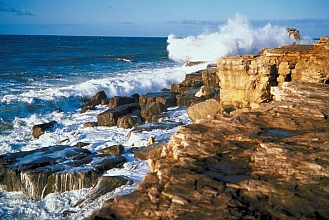View of the basalts along the northeastern coast of Baffin Island.
Click on image for full size
Image Courtesy of Don Francis, McGill University
Oldest Earth Mantle Reservoir Discovered
The Earth's mantle is a rocky, solid shell that is between the Earth's crust and the outer core. The mantle is made up of many different reservoirs that have different chemical compositions.
Scientists had already determined that the Earth was slightly older than 4.5 billion years old, but had not found a piece of the Earth's primitive mantle.
Until five years ago, scientists thought the Earth's chemical composition was chondritic. This means that the mantle was similar to that of chondrites, which are some of the oldest and most primitive objects in the solar system. Chondrites have a certain ratio of the chemical elements of helium, lead, and neodymium. But five years ago, scientists learned that the ratio of neodymium was higher than previously thought.
This new information meant that scientists needed to look in different places for the Earth's primitive mantle. Since many of the ancient rocks have melted over time, finding a piece of the primitive mantle means studying lavas.
They looked at lava samples from Baffin Island and discovered that the sample had the correct ratios of all three chemical elements--helium, lead, and neodymium. This discovery means that the sample from Baffin Island is the first evidence for the oldest mantle reservoir. This discovery will help scientists understand the composition of the original, early Earth.
You might also be interested in:

Scientists have learned that Mount Hood, Oregon's tallest mountain, has erupted in the past due to the mixing of two different types of magma. Adam Kent, a geologist at Oregon State University, says this
...more
The Earth's mantle is a rocky, solid shell that is between the Earth's crust and the outer core. The mantle is made up of many different reservoirs that have different chemical compositions. Scientists
...more
Some faults look strong and like they wouldn’t cause an earthquake. But it turns out that they can slip and slide like weak faults causing earthquakes. Scientists have been looking at one of these faults
...more
The sun goes through cycles that last approximately 11 years. These solar cycle include phases with more magnetic activity, sunspots, and solar flares. They also include phases with less activity. The
...more
Studying tree rings doesn't only tell us the age of that tree. Tree rings also show what climate was like while the tree was alive. This means that tree rings can tell us about climates of the past. Two
...more
Earth's first life form may have developed between the layers of a chunk of mica sitting like a multilayered sandwich in primordial waters, according to a new hypothesis. The mica hypothesis, which was
...more
Acid rain is what happens when some types of air pollution is washed out of the sky by rain. Power plants, factories, farms, houses, and cars all put pollution into the atmosphere. Sometimes, this pollution
...more














